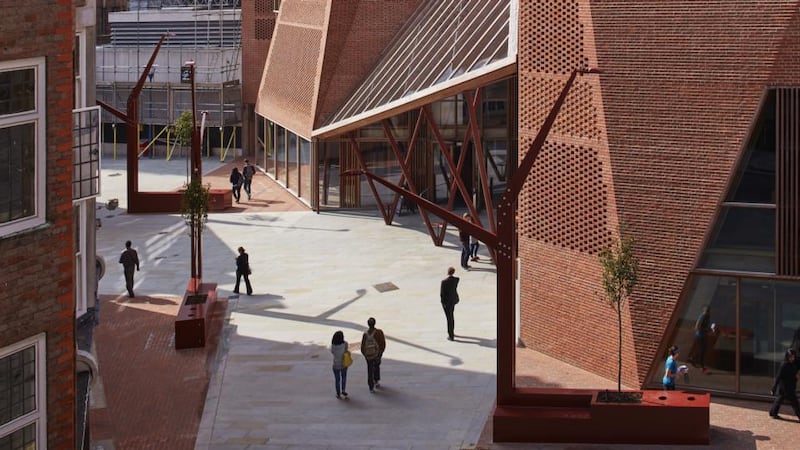They will be rolling out the black carpet for the Mies van der Rohe awards on Friday in Barcelona in the German architect's iconic pavilion (made for the 1929 Barcelona International Exhibition and rebuilt recently).
While black is the Mies van der Rohe foundation’s (Fundacio Mies van der Rohe) colour, this is architecture, remember, where black is always the new black.
Red carpets are for Hollywood but this year's prize – comprising €60,000 and monumental recognition for the best architecture in Europe in a two-year period – is more Oscars-like than in the past because the winner will be decided shortly before the on-stage envelope-opening takes place.

The jury (led by Italian architect Cino Zucchi, and including Danish architect Lene Tranberg, Bolles+Wilson co-founder Peter L Wilson, Tony Chapman of the RIBA, Chinese critic Li Xiangning and head of Mpreis supermarkets in Austria Hansjörg Mölk) has not been required to decide on a winner immediately after visiting all five buildings on the shortlist: this year they can ponder their decision.
Judges will have taken many flights and perhaps be tired and hungry and decisions can be made too hastily under a deadline, explains Giovanna Carnevali director of Fundacio Mies van der Rohe.
On the five-strong shortlist is Irish practice O'Donnell+Tuomey, which has had quite a time of it recently, winning the RIBA Gold Medal and shortlised for the Stirling Prize for the same LSE building that is up for the EU Prize for Contemporary Architecture – Mies van der Rohe award.
Sheila O’Donnell and John Tuomey’s architecture practice is 25 years old, the same age as the Mies award. “We’ve spent 25 years becoming an overnight success,” says Tuomey.
Irish performance
It's been a year for Irish architecture too. Out of the 40 projects up for the Mies award, three were by Irish practices – student housing for the medical school at University of Limerick by Grafton Architects, Waterford Medieval Museum by Waterford City Council Architects and the Saw Swee Hock student centre at the LSE by O'Donnell and Tuomey.
London-based Niall McLaughlin – Swiss-born to Irish parents and whose brother John runs an architectural practice in Ireland – also made the list for his exquisite Bishop Edward King Chapel in Oxfordshire, while Belfast-based Hall McKnight was in the top 40 for Vartov Square in Copenhagen.
In the initial list of 420 projects chosen by experts in 38 European countries, there were nine Irish practices. The most ever, says Carnevali, in Dublin to launch an exhibition of the 420 projects at UCD. “It’s amazing, we’ve never had so many from Ireland.”
Their quality, she says, is in their way of working “which is much more to do with context. They are much more silent works this year.”
John Tuomey, head of the school of architecture at UCD, lights up at this: "This is what we've been trying to teach all our lives," he says, turning to Carnevali: "Although maybe not silent but quiet."
Yes, agrees Carnevali: “Not silent but not star-architects. There has been a move away from loud buildings.”
So that’s it, loud buildings are over? She protests slightly at having to make a definite statement to a journalist but then laughs and says: “Yes, loud buildings are the past.”
Now it is about the meaning of the project – in itself or for a city or client – rather than a statement by an architect, she says. “Mies van der Rohe said quality has to be intrinsic.”
Being part of the European conversation is important to O'Donnell and Tuomey, who have been in the top 40 five times before but never on the final shortlist. "We've always felt we were reaching to Europe rather than the US," says O'Donnell, who travelled to Italy, Spain and Greece, with Tuomey, after they left college.
"We think of ourselves working here in Dublin as Europeans working in the context of a European city. That is the forum we look to for our work to be discussed in. The judges are from across Europe so there is a sense of our work being discussed beyond Ireland and England. "
She talks about how buildings seem to grow out of European streets whereas in the US grid system you could almost put any building in a street or take it out. That is how she sees their LSE building: just after they finished it, the couple went to Athens and, walking up steps that incorporate seats, platforms and cafes, they realised that is what they had designed in London.
“We are part of the generation that witnessed the Europeanisation of Ireland,” says Tuomey.
Process of design
He likes the fact practices don’t nominate themselves for this award – experts in different countries put forward projects . “So there is an ingrained understanding of the process of design.”
The pair say how warm and generous people have been about their recent successes. “Irish architecture is not a vipers’ nest,” says Tuomey. “Really?” says Carnevali, somewhat surprised.
In turn, they are generous about other architects. “The generation coming up in Ireland is really talented,” says O’Donnell – now they just need post-bust work.
The architects have to give a short presentation of their work in Barcelona and on Friday, when the envelope is opened, hopefully they will be part of an exultant swoosh down the black carpet.











